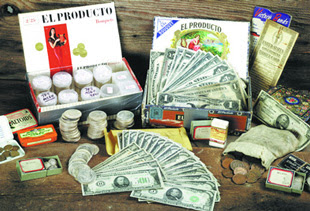Written by the TreasureGuide for the exclusive use of the Treasure Beaches Report.
 |
| Vermont Yankee Hoard Source: See Littleton Coin Company link below. |
Treasure hunters and metal detectorists who dream of finding a hoard will be benefited by considering how hoards have been accumulated, stored and discovered.
Here is that link.
Famous Hoards - Littleton Coin Company
----
Here is the story of the Economite Hoard.
... the famous Economite Treasure, believed concealed in the late 1830s and rediscovered in 1878. Found in the town of Economy, Pennsylvania, the coins had been hidden away by members of the Harmony Society, a communal group headed by George Rapp, who claimed divine guidance. Today, we would certainly regard this group as a cult. The Economy community was modestly successful in the mid 19th century and played a small role in financing several projects around Western Pennsylvania and Indiana.
In any event, in or around 1836, the "Rappites" as they were called, sealed approximately $75,000 in face value of U.S. silver coins in a vault and covered it in brick and mortar. For the next 42 years or so, the coins remained sealed in the dark, damp vault. Then in late 1878, the coins were found, blackened and tarnished from their long storage....
Here is the link for more about that hoard.
A History of Major U.S. Hoards: The Economite Treasure (pcgs.com)
---
Below are a couple paragraphs from a history of U. S. coins.
In time, some Spanish, Portuguese and French coins appeared in the colonies as a result of trade with the West Indies. The most famous of these was the Spanish Dollar, which served as the unofficial national currency of the colonies for much of the 17th and 18th centuries. With its distinctive design and consistent silver content, the Spanish dollar was the most trustworthy coin the colonists knew. To make change the dollar was actually cut into eight pieces or “bits.” Thus came the terms "pieces of eight" from these early times and "two bits" from our time.
In 1652, Massachusetts challenged England's ban on colonial coinage. The colony struck a series of silver coins, including the Pine Tree Shilling. On the coin the lettering MASATHVSETS IN encircles a pine tree. The reverse bears the inscription NEW ENGLAND AN DOM, the date 1652 and the Roman numeral XII (twelve pence or one shilling) in the center...
Money in Colonial Times (philadelphiafed.org)
---
I'll skip down to 1997.
And here is the link for the intermediate years and another table giving the number of notes in circulation for the various years.
Currency in Circulation | U.S. Currency Education Program (uscurrency.gov)
---
Disney's growing anti-traditional values political stance is taking the company down the drain, and the Marxist are naturally happy about that, especially since Disney was such a powerful American cultural icon.
In France, "Nahel's death has fed longstanding complaints of police violence and systemic racism inside law enforcement agencies from rights groups and within the low-income, racially mixed suburbs that ring major cities in France."
Low income groups are being interjected into alien Western cultures to provide conflict and the critical mass for riot and rebellion. The great reset accelerates.
---
I'll be doing much more on hoards in future posts.
Nothing much of interest on the weather front.
Good hunting,
Treasureguide@comcast.net

